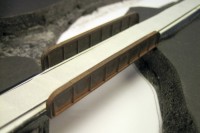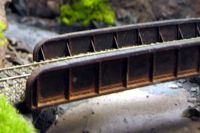
Plate Girder Through Bridge
In real life, the overall dimensions of the girders of a plate girder bridge are always proportional to the length of the bridge, which means an N scale plate girder is perfectly fine to use in Z. Really! The only thing wrong, if you want to get picky, is that the rivets and other fine details will be oversized by about 25%. But this minor discrepancy is very easy to live with, as far as I'm concerned.
  |
Thus, Micro Engineering makes a couple of nice Z scale plate girder bridge kits, and hardly anyone knows it—including Micro Engineering. Their N scale 40-foot deck and through bridges become 55-foot Z scale bridges. Since girder depth can vary a little according to the load the bridge is designed to carry, it's perfectly fine to lop off one or two panels to make slightly heavier-duty 40- or 48-foot girders. Also, Atlas makes a one-piece N scale 65-foot through plate girder bridge (since it has no inside-surface detail, it doesn't make a very good through bridge, but it works fine as a deck). With one panel cut off, it can serve as an 80-foot Z scale deck bridge.
The James River Branch was in need of a single skewed through plate girder bridge. I started with the Micro Engineering kit and made just a few modifications. First, I rounded the top end corners of the girders to change the look (this style was common on the Reading), then bonded a pair of the edge plates end-to-end to the top and ends, wrapping them around the curved corners, to make use of the parts' nice rivet details.
The girders are glued to a piece of sheet styrene cut to the overall size and shape of the bridge to hold everything together. Everything was sprayed with flat black, followed by a heavy misting of ruddy primer. Then everything received several generous applications of Rustall and Doctor Ben's Weathered Rust. The bridge was installed by simply gluing it to the underside of the sheet styrene roadbed. The triangular gussets were added just prior to ballasting, and the abutments were installed last.
Copyright © 2007-2013 by David K. Smith. All Rights Reserved.